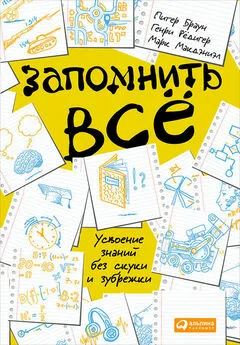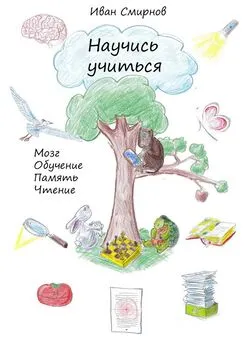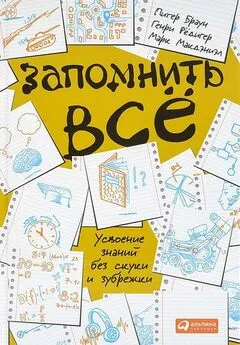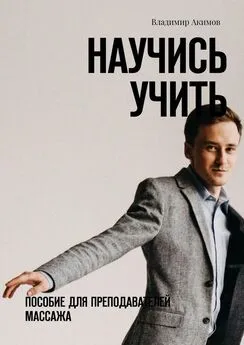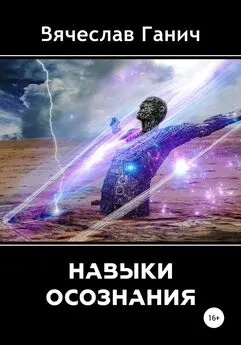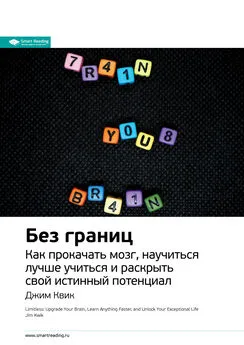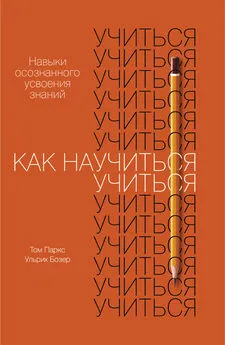Ульрих Бозер - Как научиться учиться [Навыки осознанного усвоения знаний]
- Название:Как научиться учиться [Навыки осознанного усвоения знаний]
- Автор:
- Жанр:
- Издательство:Альпина Паблишер
- Год:2020
- Город:Москва
- ISBN:978-5-9614-3365-4
- Рейтинг:
- Избранное:Добавить в избранное
-
Отзывы:
-
Ваша оценка:
Ульрих Бозер - Как научиться учиться [Навыки осознанного усвоения знаний] краткое содержание
Как научиться учиться [Навыки осознанного усвоения знаний] - читать онлайн бесплатно ознакомительный отрывок
Интервал:
Закладка:
15. Richard E. Nisbett, Mindware: Tools for Smart Thinking (New York: Farrar, Straus and Giroux, 2015).
16. Ellen Maguire, «At Jackson Pollock's Hamptons House, a Life in Spatters», New York Times , July 14, 2006.
17. Sian Beilock, How the Body Knows Its Mind: The Surprising Power of the Physical Environment to Influence How You Think and Feel (New York: Atria Books, Simon & Schuster, 2015).
18. Текст о симуляциях написан на основании моего старого текста: Ulrich Boser, «Gaming the System, One Click at a Time», Special Report: E-learning, U. S. News & World Report , October 28, 2002.
19. «Richard Feynman — Session IV», American Institute of Physics, https://www.aip.org/history-programs/niels-bohr-library/oral-histories/5020-4(дата обращения: 16.09.2016).
20. J. F. Nestojko et al., «Expecting to Teach Enhances Learning and Organization of Knowledge in Free Recall of Text Passages», Memory & Cognition , 42, no. 7 (2014): 1038–48, doi: 10.3758/s13421-014-0416-z. Also see Catherine C. Chase et al., «Teachable Agents and the Protégé Effect: Increasing the Effort Toward Learning», Journal of Science Education and Technology 18, no. 4 (2009): 334–352.
21. Также упоминается: Kenneth R. Koedinger et al., «Learning Is Not a Spectator Sport: Doing Is Better Than Watching for Learning from a MOOC», Proceedings of the Second (2015) ACM Conference on Learning @ Scale, New York: ACM (2015): 111–120.
22. David L. Goodstein and Judith R. Goodstein , Feynman's Lost Lecture: The Motion of Planets Around the Sun , vol. 1 (New York: W. W. Norton, 1996).
23. Marlene Schomer, «Effects of Beliefs about the Nature of Knowledge on Comprehension», Journal of Educational Psychology 82, no. 3 (1990): 498–504.
24. О работе Марка Рунко, упомянутой я впервые узнал из: Po Bronson and Ashley Merryman, «Forget Brainstorming», Newsweek , July 12, 2010, http://www.newsweek.com/forget-brainstorming-74223(дата обращения: 16.09.2016). Также в этой работе я использовал: Mark Runco, «Seven Critical Components of Creativity: Full Research Summary», Center for Childhood Creativity (2014): 1–19.
25. Больше информации о работе Сойера можно найти в: Keith Sawyer, Zig Zag: The Surprising Path to Greater Creativity (San Francisco: Wiley, Jossey-Bass, 2013).
26. A. Maurits van der Veen, «The Dutch Tulip Mania: The Social Politics of a Financial Bubble», Journal of Political Economy 97, no. 3 (2012): 535–60; Christian C. Day, «Is There a Tulip in Your Future? Ruminations on Tulip Mania and the Innovative Dutch Futures Markets », Journal des Economistes et des Etudes Humaines 14, no. 2 (2004): 151–70; и Mike Dash, Tulipomania: The Story of the World's Most Coveted Flower & the Extraordinary Passions It Aroused (New York: Three Rivers Press, 1999).
27. Sheen S. Levine et al., «Ethnic Diversity Deflates Price Bubbles», Proceedings of the National Academy of Sciences 111, no. 52 (2014): 18524–29, doi:10.1073/pnas.1407301111. Левайн также сообщил мне о научном исследовании, упомянутом здесь же: Nancy DiTomaso, Corinne Post, and Rochelle Parks-Yancy, «Workforce Diversity and Inequality: Power, Status, and Numbers», Annual Review of Sociology 33 (2007): 473–501.
28. The Difference: How the Power of Diversity Creates Better Groups, Firms, Schools, and Societies (Princeton, NJ: Princeton University Press, 2007). Также я использовал: Steven Johnson, Future Perfect: The Case for Progress in a Networked Age (New York: Riverhead Books, 2012).
29. В рассуждениях о технологиях и разнообразии мне помогла статья: Chris Paris, «The Wonderful — Yet Misunderstood — World of Wikis», Seminarium, April 11, 2014, http://seminariumblog.org/general/semtech/wonderful-yet-misunderstood-world-wikis(дата обращения: 16.09.2016).
30. Цитаты о плохих способностях Поллока как художника взяты из книг Деборы Соломон и Адамса соответственно.
31. Daniel Kahneman, Thinking, Fast and Slow (New York: Farrar, Straus and Giroux, 2011).
32. Фейнман, Р. Вы, конечно, шутите, мистер Фейнман! М.: Колибри, 2008. Цитата из Дэвиса из: Gerald Lyn Early , Miles Davis and American Culture (St. Louis: Missouri History Museum, 2001).
Barlow, Claire M., Richard P. Jolley, and Jenny L. Hallam. «Drawings as Memory Aids: Optimizing the Drawing Method to Facilitate Young Children's Recall.» Applied Cognitive Psychology 25, no. 3 (2011): 480–87. doi:10.1002/acp.1716.
D'Mello, Sidney, Blair Lehman, Reinhard Pekrun, and Art Graesser. «Confusion Can Be Beneficial for Learning.» Learning and Instruction 29 (2014): 153‒170.
Fiorella, Logan, and Richard E. Mayer. «The Relative Benefits of Learning by Teaching and Teaching Expectancy.» Contemporary Educational Psychology 38, no. 4 (2013): 281–88. doi:10.1016/j.cedpsych.2013.06.001.
Kuhn, Deanna. The Skills of Argument. New York: Cambridge University Press, 1991.
Krontiris-Litowitz, Johanna. «Articulating Scientific Reasoning Improves Student Learning in an Undergraduate Anatomy and Physiology Course.» CBE Life Sciences Education 8, no. 4 (Winter 2009): 309. doi:10.1187/cbe.08-11-0066.
Mayer, Richard E., and Logan Fiorella. Learning as a Generative Activity: Eight Learning Strategies That Promote Understanding . Cambridge, UK: Cambridge University Press, 2015.
Okita, Sandra Y. «Learning from the Folly of Others: Learning to Self-Correct by Monitoring the Reasoning of Virtual Characters in a Computer-Supported Mathematics Learning Environment.» Computers & Education 71 (2014): 257–278.
Osborne, Jonathan. «Arguing to Learn in Science: The Role of Collaborative, Critical Discourse.» Science 328, no. 5977 (2010): 463–466.
Willingham, Daniel T. Why Don't Students Like School? A Cognitive Scientist Answers Questions about How the Mind Works and What It Means for the Classroom . San Francisco: Jossey-Bass, 2010.
Глава 5
1. Walter Isaacson, Einstein: His Life and Universe , 1st ed. (New York: Simon & Schuster, 2007), и Isaacson, «The Light-Beam Rider», New York Times , October 30, 2015, http://www.nytimes.com/2015/11/01/opinion/sunday/the-light-beam-rider.html(дата обращения: 14.09.2016). Цитаты из Эйнштейна также взяты из книги Айзексона.
2. Также см.: John D. Norton, «Chasing a Beam of Light: Einstein's Most Famous Thought Experiment», University of Pittsburgh, April 14, 2005, http://www.pitt.edu/~jdnorton/Goodies/Chasing_the_light/(дата обращения: 14.09.2016).
3. В описании подробностей подводного эксперимента я опирался на: John D. Bransford et al., How People Learn: Brain, Mind, Experience, and School (Washington, DC: National Academics Press, 2000). Также мной использована статья: Lindsey Engle Richland and Nina Simms, «Analogy, Higher Order Thinking, and Education», Wiley Interdisciplinary Reviews: Cognitive Science 6, no. 2 (March 2015): 177–92, doi:10.1002/wcs.1336.
4. David W. Braithwaite and Robert L. Goldstone, «Effects of Variation and Prior Knowledge on Abstract Concept Learning», Cognition and Instruction 33, no. 3 (2015): 226–256.
5. Более развернутое объяснение ответа на задачу про короля дает Голдстоун: «Каждая провинция должна быть отдана какой-то из дочерей. Есть 7 дочерей. Если бы провинция была только одна, вариантов было бы 7. Если бы провинций было 2, то на каждый из 7 вариантов завещания первой провинции приходилось бы 7 вариантов завещания второй провинции (то, что Гертруда получила бы Францию, не означало бы, что она же может получить и Германию). Каждая новая провинция, которая должна отойти одной дочери, умножается на 7 — число возможных вариантов распределения».
Хочу отметить, что чередование различных задач не всегда дает положительный результат — по крайней мере на ранних стадиях обучения. Голдстоун говорит: «Мы с Дэвидом Брейтуэйтом обнаружили, что вариации задач, основанных на одном и том же глубинном принципе, не всегда обеспечивают преимущества в обучении. В частности, чем больше вы знаете, тем лучше способны „справляться“ с вариациями. Людям с относительно низким изначальным уровнем понимания соответствующих математических принципов полезнее тренироваться на похожих задачах, не сильно отличающихся одна от другой».
6. Задача взята из: B. H. Ross, J. P. Mestre, and J. L. Docktor, «Understanding How to Teach Physics Understanding», Integrating Cognitive Science with Innovative Teaching in STEM Disciplines , eds. M. McDaniel, R. Frey, S. Fitzpatrick, and H. L. Roediger (Saint Louis: Washington University Libraries, 2014), doi: 10.7936/K79G5JR7.
7. Исследования о разнообразии практики описаны в: Dennis K. Landin, Edward P. Hebert, and Malcolm Fairweather, «The Effects of Variable Practice on the Performance of a Basketball Skill», Research Quarterly for Exercise and Sport 64, no. 2 (1993): 232–237, doi:10.1080/02701367.1993.10608803. Также см.: Gavin Breslin et al., «Constant or Variable Practice: Recreating the Especial Skill Effect», Acta Psychologica 140, no. 2 (2012): 154–57.
8. Alan Deutschman, The Second Coming of Steve Jobs (New York: Crown Business, 2001). Цитата из Гопник из: Alison Gopnik and Caren M. Walker, «Considering Counterfactuals: The Relationship between Causal Learning and Pretend Play», American Journal of Play 6, no. 1 (2013): 15. Alison Gopnik, Andrew N. Meltzoff, and Patricia K. Kuhl, The Scientist in the Crib: Minds, Brains, and How Children Learn (New York: William Morrow, 1999).
Читать дальшеИнтервал:
Закладка:
![Обложка книги Ульрих Бозер - Как научиться учиться [Навыки осознанного усвоения знаний]](/books/1065368/ulrih-bozer-kak-nauchitsya-uchitsya-navyki-osoznan.webp)
